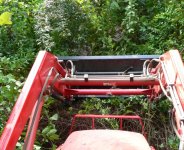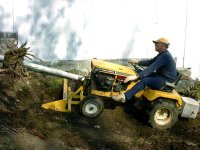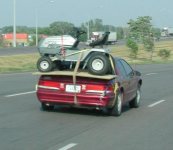Pardon me while I rant...
If you wanted to add a couple of adverbs to the word
do you could end this entire discussion promptly... adverbs like quickly or easily or affordably...
While a CUT/SCUT with a grapple bucket can do this, lifting and carrying logs and brush:
Or a CUT/SCUT with a backhoe can do this, pulling up small trees and stumps, roots and all:
Can it then readily do this -- transporting those trees and logs putting them on the top of the brush pile -- all without ever leaving the seat, swapping implements, etc. Basically you can do it as fast as you can drive from one location to the next:
And can you just as quickly do those tasks in close quarters, like this, maneuvering between trees:
And producing results like these -- all without leaving the seat, unless it's to connect/disconnect a hydraulic hose?
And do it safely and comfortably on slopes like these, without slipping, spinning or bumping into things -- i.e. no turf damage nor damage to the landscaping, your machine or yourself?
I don't think so... if you want to work in the "Back 40" and you've got wide open spaces, the CUT/SCUT will do fine, if you want to hassle with swapping implements and perhaps even swapping seats if using the backhoe. If you want to use it on a construction site, it'll do fine, as long as you have plenty of room to maneuver. (Note there's a reason you see skidsteers on construction sites!)
But, get it in close quarters, up close to buildings, around your landscaping, or in the woods, or on slopes, and a PT will simply do things a CUT owner can only dream about, without ever leaving the seat unless it's to connect/disconnect a hydraulic hose...
Let's face it -- a CUT/SCUT is just a down-sized farm tractor, designed for working in fields, pulling its implements in wide-open spaces. Even down-sized, it's still best suited for open spaces, where visibility, maneuverability and precision placement of the implement are not major factors -- nor is it designed to change implements more frequently than about once per work day, if at all ... in fact, many are machines dedicated to the specific purpose of their mounted implements, to prevent having to change them, adjust them, and get them ready to use. How often are backhoes and FELs removed, for example? How hard and time consuming is it?
I still can't believe that so many people defend CUTs/SCUTs when many of them will never use them to do what they were originally intended to do -- pull plows and harrows and other ground-engaging tools, leaving the prepared area behind you...
(a) Though CUTs/SCUTs can pull mowers, does it really make sense to run over your lawn, mashing the grass down, before you mow the grass with your RFM? Or if you use a belly-mower (that only runs over the grass with two front wheels before cutting), is it is so heavy and hard to remove/install that you tend to leave it on all the time -- or leave it off all the time? Using a rough-cut mower, does it really make sense to drive through those briars and saplings before you cut them down and chop them up? Some would say it's beneficial to drive with your FEL down low, "feeling for" hidden stumps, rocks, etc., to which I'd respond that if your big hood and FEL weren't blocking your view, they wouldn't be hidden... and if your attention wasn't diverted, looking behind you at your cutter, you just might see those items before you ran over them...
(b) Though they can pull a box-blade or angle blade, does it make sense to have the tractor travel over that rough terrain while trying to simultaneously, manually control the implement to smooth out that rough terrain behind you? Or to need to reinforce your lift arms (and may still risk tranny damage) if you use that box-blade to push instead of pull, so you can drive and work on smoother terrain? Does it make sense to have to get off the tractor to adjust your toplink to control the bite, or invest in more hydraulics and controls to prevent doing so? Similarly, does it make sense to travel over the snow before trying to plow it aside -- or do the majority of your work in reverse, where your tires provide less traction on those slippery surfaces and you likely aren't as accurate with placement of the implement ?
(c) Does it make sense to have your few available front-mounted implements hidden by a long, high hood so you may have to lean to the side to see where they are and what's around them? Does it make sense for that FEL to be so troublesome to remove that it stays on all the time, blocking your view, limiting your maneuverability even more, and risking damage as it swings around in tight, blind spots? Does it make sense that you need to hang as much extra weight (often another big bulky implement like a boxblade or rough-cut mower) off the other end of the tractor as you want to pick up in that FEL, to balance it, adding strain to your entire running gear, and increasing the damage to your lawn and increasing your problems on softer terrain, while again dramatically limiting maneuverability? BTW, anyone who's used either a "front-end loader" or a "skidsteer" will tell you that an ag-style tractor is a
very poor substitute in loader work, for MANY reasons.
(d) Does it make sense to have to twist around and watch the majority of your implements dragging behind you, all the while trying to drive forward -- where your view is still obstructed by that hood and likely that FEL and bucket also? Does it make sense for those implements to be mounted such that you often can't see an obstruction (like a stump) before you hit it with your implement -- or if you do see it come out from underneath your tractor, you don't have enough reaction time to respond? Does it make sense to deal with having your attention constantly divided between where you're driving and your watching and controlling the implement you're using?
IMO, the answer is a resounding
NO! Many people who own small properties buy CUTs/SCUTs because that's all they've ever known, or seen, or it's what someone else has recommended... not because they've really thought about what their needs are to maintain their property and what might be the
best overall tool set to accomplish their tasks and meet their needs...
The PTs provide visibility, maneuverability and lifting ability similar to a equivalent weight skid-steer -- without the spinning, skidding and resultant soil damage. They provide all the advantages of front-mounted skidsteer attachments (visibility, precision placement, ability to lift them high, built-in implement tilt functions, etc.), at a fraction of the cost of heavy-duty skidsteer attachments and at a price that's actually competitive, overall, with those for traditional CUTs/SCUTs...
IMO, most PT owners will tell you that they couldn't really understand and appreciate the agility, maneuverability and speed with which they can work until
AFTER they bought their PT and got used to it... They'll tell you that they
never anticipated nor appreciated how valuable it is to be able to closely watch your implement at all times, and to quickly change from one implement to another, several times a day or even several times while performing one chore, as their needs change...
IMO, if a reasonable alternative to PT does come on the market, it likely won't come from the "tractor guys" who seem to think "bigger is always better" -- it will likely come up from the "mini-skidsteer" folks who got tired of walking or standing, and want to ride... yet still need the small size, light weight, maneuverability and versatility similar to what they've become accustomed to... But, even then it may not be affordable, because it will likely be intended for commercial (not residential) use!
Rant over.....

















